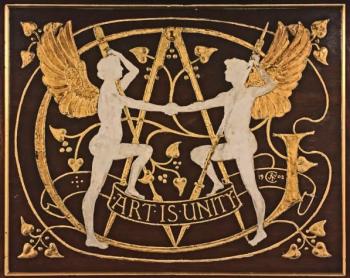Art Workers' Guild
The Guild was founded in 1884 with the main purpose of bringing together artists, craftsmen, and architects. The main protagonists included John Ruskin, William Morris, designers/artists such as Walter Crane and Lewis F. Day, and the St. George's Art Society, composed of six architects, all but one of them pupils of Richard Norman Shaw. The desire to form a society such as the Guild reflected a widespread longing to create social contact between members of different artistic professions, for whom there was no existing institutional meeting place. They were scornful of the hierarchical divisions of the Royal Academy, where painting was elevated above the other arts.
The architectural weight of the Guild was characteristic of the way in which the Arts and Crafts Movement grew out of the Gothic Revival, with its stress on a diversity of design talent through which constructions might revert to the integrated richness of a bygone period. The original and only method of election was by the proposal of an existing member or members and on the quality of their work. During its early years, the Guild attracted an eminent membership which included many high-flying young architects, painters, sculptors and designers of the period. They often worked in partnership, on buildings such as the church of Holy Trinity, Sloane Street (architect J. D. Sedding), or the Institute of Chartered Accountants (architect J. D. Belcher), which are still extant. The Guild is headed by a master and illustrious Past Masters include Walter Crane, William Morris, Selwyn Image, Frank Short, George Frampton, William Strang, Sir George Clausen and W. R. Lethaby.
In 1961 the Society changed its name to the Society of Designer-Craftsmen.
Get Unlimited Access from just £5


